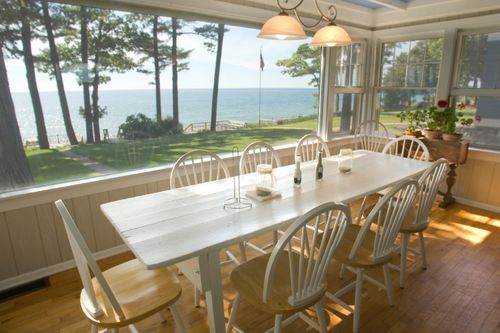Buying a house with a dog

Buying a Home With Your Dog in Mind 🐾
When it comes to finding the perfect home, it’s not just about bedrooms, kitchens, or commute times—it’s also about your four-legged family members. If you’re a dog owner in Seattle, keeping your pup’s needs in mind can make the difference between a good house and the perfect home.
Here are the top 6 things to look for when buying a home with your dog:
1. A Secure, Fenced Yard
Dogs need space to run, play, and sniff. A fenced yard provides a safe environment for your pup to exercise without worry. Bonus: it makes quick bathroom breaks much easier on rainy Seattle mornings.
2. Pet-Friendly Floors & Stairs
Not all flooring is created equal. Hardwood, laminate, or vinyl are better choices than carpet or tile, making cleanup easier and keeping paws comfortable. Pay attention to staircases too—gentle stairs are safer for senior dogs and larger breeds.
3. Access to Parks & Trails
Seattle is full of dog-friendly parks, off-leash areas, and scenic trails. Living close to green space makes daily walks more enjoyable and helps your dog burn off extra energy. Think of it as built-in enrichment for your best friend.
4. Water Access for Swim-Loving Pups
We’re lucky to have lakes, rivers, and Puget Sound right in our backyard. If your dog loves the water, look for neighborhoods with safe swimming spots nearby. It’s a great way to combine exercise and play.
5. HOA Rules to Check Twice
Before you fall in love with a home, read through any HOA documents carefully. Some have restrictions on dog breeds, sizes, or even the number of pets allowed. It’s always better to know before you buy.
6. Sidewalks for Safe Walks
A neighborhood with sidewalks isn’t just safer for you—it’s safer for your dog too. Wide, well-lit sidewalks make evening walks easier and help keep you out of busy streets. Magnolia Boulevard, for example, is a great area to check out.
Bonus: Mudroom or Pet Wash Station
While not essential, a laundry room or mudroom near the entryway is a lifesaver for muddy paws during Seattle’s rainy season. It keeps your living spaces cleaner and your dog happier.
Ready to Find a Dog-Friendly Home?
Every home is different—let’s find one that works for you and your furry friend.
🐾 DM me today for dog-friendly listings in Seattle and beyond!
For Rent in Magnolia

Description
Condo for Rent
Enjoy the charm of Seattle’s Magnolia neighborhood with all it has to offer! This bright and spacious 1-bedroom, 1-bath condo features an open floorplan, vaulted ceilings, and abundant natural light. Situated in a quiet residential area above a garage, you’ll appreciate the comfort of condo living without the noise from neighbors below.
Step outside and take advantage of the close proximity to downtown Seattle, explore Discovery Park’s trails and beaches, or bike along scenic paths nearby on the Gilman trail. You’ll be just minutes from the Village at Magnolia (downtown Magnolia) with its shops, cafes, and restaurants, and close to the iconic Ballard Locks.
This home is ideal for those seeking a peaceful retreat with easy access to the best of Magnolia and the surrounding area.
Amenities
| Brand New Construction Interbay Golf Course Air Conditioned Heated Floors Fully Furnished Large Kitchen Light and Bright Vaulted Ceilings | Open Floor Plan Quiet and Private Shopping Nearby Magnolia Village Sleeps 4 people Discovery Park Dog Park |
Virtual Tour
Contact us
Selling your house? Here is a checklist to get started.

Home Selling Checklist

First impressions are key when selling, so it’s important to put in the time to make sure your home is in top condition. Fresh paint, clean closets, flowers; there’s a lot you can do to make even the humblest of homes look like a million bucks. Check out our Get Ready To Sell checklist below for a list of ideas and tips.
Get Ready to Sell Checklist
Want your own copy?
Download a PDF version at the link below
A Checklist on how to prepare your house for sale

Getting your home ready to sell can feel like a circus act. Without the right organization, juggling the countless moving parts involved in this stage of the selling process can take its toll. This is the perfect opportunity to create a checklist to keep yourself on track and within your budget. The following information will illuminate the key responsibilities you face as a homeowner as you prepare to hit the market.
We’ve included a comprehensive checklist below of the common tasks required to get your home ready to sell. It is also available as an interactive web page and downloadable pdf here: Get Ready to Sell Checklist
Preparing to Sell Your Home: Working with an Agent
Before you start working on the house itself, it’s best to get the ball rolling on the strategic aspects of selling a home. Working with a real estate agent is the best way to get your home sold for the best price in a timely manner.
A listing agent will represent you throughout the selling process to determine the value of your home, coordinate open houses, market the property, and negotiate with buyers to reach a deal. In the early stages of your discussions with your agent, they will conduct a Comparative Market Analysis (CMA) to see what price your home could fetch on the market, accounting for various factors that influence home prices such as seasonality and local market conditions. Based on the findings of your agent’s CMA, you can discuss whether remodeling fits into your go-to-market strategy, and your agent can provide intel on which remodeling projects could deliver significant ROI based on buying trends, your location, and what comparable listings in your market are offering.
Home value estimation tools can help you get an idea of what your home is worth to facilitate your conversations with your agent. Use our free Home Worth Calculator by clicking the button below:

Image Source: Getty Images – Image Credit: FG Trade
Preparing to Sell Your Home: A Complete Checklist
Once you’ve found an agent, you’re ready to get your home in tip-top selling shape. The following checklist is available as a free downloadable PDF here:
Get Ready to Sell Checklist – PDF
Exterior
This list of value-adding curb appeal projects will help to form buyers’ first impressions of your home and make your ever-important exterior listing photos stand out amongst the competition.
- Remove peeling and chipped paint; replace with a fresh coat
- Fix loose trim and fencing
- Clear gutters and downspouts
- Make sure there is good exterior lighting and all walkway lights and front-door lanterns work
- Clean and repair the roof as needed
- Clear garage of clutter and tidy shelves
- Inspect chimney for cracks and damage
Yard
- Mow and trim grass; re-seed and fertilize where necessary
- Prune all overgrown trees and shrubs
- Weed flowers beds
- Remove or replace dead or diseased plants, shrubs, and trees
- Clean grease and oil stains from driveway
Decks/Patios
- Paint or stain worn areas on wood decks
- Remove grass growing in concrete cracks; sweep off debris from shrubs and trees
- Clean all deck rails and make sure they’re secure; replace missing slats or posts
- Clean outdoor furniture
Front Door
- Polish or stain worn areas on wood decks
- Add a fresh coat of paint to get rid of nicks
- Clean the glass on the storm door; make certain the screen is secure
- Make sure the doorbell operates properly and there are no squeaks when the door opens and closes
Windows
- Clean all windows inside and out
- If needed, add a fresh coat of paint to the window trims and sills
- Make sure all windows open and close easily
- Replace cracked windowpanes and those with broken seals
- Make sure window screens are clean and secure; replace any screens with holes or tears
Front Entry
- Clean entryway floors and area rugs
- Downsize clutter in the entry and entry closet to give the appearance of spaciousness
- Double-check entry lighting to make sure it works
Interior
Not only will these interior projects get your house sparkling clean, but they’re also preparatory steps for staging your home and hosting open houses.
General Interior Cleaning
- Clean all floors, carpets, walls, and trim
- Replace burned-out light bulbs
- Empty trash
- Remove family photos, valuables, and prescription drugs
- Tidy up clutter
Kitchen
- Fix dripping faucets
- Organize pantry and cupboards so they appear clean, neat, and spacious
- Make sure the refrigerator and freezer are defrosted and free of odors
- Clean the oven and cook top thoroughly
- Set the table
Living/Family/Dining Rooms
- Give rooms a fresh coat of paint as needed
- Repair cracks and holes in ceiling and walls
- Make sure all wallpaper is secure
- Repaint any woodwork that is worn or chipped
- Clean or replace draperies and blinds; open them to maximize light
- Make sure draperies and blinds open and close
- Steam-clean carpets
- Clean rugs and wood flooring, and remove any stains or odors
- Position the furniture to showcase the size and space of the room
- Remove and replace any attached items, such as chandeliers and draperies, that you wish to move with you
- Put away toys and hobby supplies; remove extra magazines and books from tables
Bathrooms
- Make sure sinks, tubs, showers, and countertops are clean and free of stains
- Repair any leaky faucets
- Remove grout and soap stains from tile
- Replace any missing or cracked tiles or grout
- Make sure all joints are caulked
- Make sure all fixtures, including heat lamps and exhaust fans are operating
- Install a new shower curtain and buy matching towels
- Store all supplies, such as toilet paper, shampoo bottles and cleansers, out of sight
Bedrooms
- Repair cracks in ceiling and walls
- Apply a fresh coat of paint if necessary
- Make sure all wallpaper is secure
- Clean draperies and blinds; open them to maximize light
- Put away toys, clothes, and clutter
- Neatly make up the beds
Basement
- Check for water penetration or dampness; call for professional repairs if necessary
- Get rid of musty odors
- Clean furnace, hot water heater, and drains
- Make sure light fixtures work
- Arrange storage area in a neat and organized manner
- Make sure stairway handrail is secure
Tidy Extras
- Use air fresheners or bake treats to make the house smell good
- Plant flowers to brighten the walkway and enrich the entry
- Remove any indoor houseplants that are brown or losing their leaves
- Remove all “fixer” cars, campers, and boats from the property
- Discard the clutter of magazines on the coffee and end tables
- Tidy and declutter all closets
- Hide or get rid of worn-out throw pillows
- Store pet supplies
- At night, turn on the porch light and outdoor lighting
- Put away toys and hobby supplies; remove extra magazines and books from tables
For more information on preparing to sell your home, helpful hints on the rest of the selling process, tips on working with an agent, moving checklists, and more, visit our Home Selling Guide:
Should I Buy a Waterfront Home?

A waterfront home offers surroundings unlike any other. Their prime locale and stunning views virtually guarantee a lifetime of relaxation, waterfront get-togethers, and summer nights under the stars. Waterfront homes have great potential as investment properties as well. But for all the perks waterfront homeownership offers, it comes with its own set of responsibilities, too.
Should I buy a waterfront home?
Beyond the lifestyle benefits, owning a waterfront home also has a significant financial upside. Because waterfront properties are more scarce than landlocked homes and their location is highly desirable, the buyer demand is generally high. As a homeowner of these special properties, you can rest assured that a well-maintained waterfront home will generate significant buyer interest when you’re ready to sell. A property with any combination of water views, boat slips, docks, and water access is a recipe for appreciation over time.
A waterfront property is a popular choice for homeowners who are in the market for a second home, or even as a primary residence for those looking to eventually move into their vacation home when the time is right. They’re also primed for converting into a short-term rental. Due to their location, they have a competitive advantage over many other short-term rentals. Depending on the local laws and any relevant Homeowners Association rules, waterfront homes can be rented out year-round or seasonally. For example, if you decide to rent out your home during the summer, you’re able to capitalize on seasonal demand.

Image Source: Getty Images – Image Credit: bradwieland
Owning a waterfront property also comes with extra risks you’ll need to keep in mind. Weather conditions can be extra harsh on these homes, given the fact that they’re situated face to face with nature in a way most homes aren’t. Make sure you have proper coverage through your homeowners insurance policy and inquire about the need to purchase additional wind, flood, or hazard coverage. Local climate dictates what a comprehensive coverage plan will look like for your home, but what’s important is that you’re fully covered.
Something else to keep in mind is that beyond the typical tasks associated with owning a home, waterfront structures like retaining walls, boat lifts, and docks require a certain amount of ongoing maintenance. As the seasons change, so will your responsibilities as a homeowner. Properly winterizing a waterfront property requires a few additional steps beyond the typical routine, depending on how low temperatures dip during winter in your area.
For more advice on home maintenance, repairs, remodeling and more, visit the Living section of our blog:
How to Increase Your Buying Power

One of the best ways prospective home buyers can empower themselves when purchasing a home is to improve their buying power. The numbers may seem daunting but identifying ways to strengthen your financial standing will help you each step of the way.
When visualizing your dream home, it’s common for buyers to focus on the physical characteristics. But to mortgage lenders, a home is a numbers game. The following categories related to your buying power demonstrate how lenders identify your financial standing and determine your eligibility for a home purchase. Improvements in these areas will increase your buying power, propelling the strength of your offer when you’re ready to put it on the table.
How to Increase Your Buying Power
Increase Savings For Your Down Payment
As the saying goes, cash is king. The down payment—often 20% of the home’s sale price—can sometimes be the deciding factor between competing offers for a particular home.
Try stashing away a little of each paycheck to build up your savings over time. Set a savings goal, commit a dedicated amount to each pay period, and watch the savings build as time goes on. If you prefer to keep your money separate, open a new account to which you can dedicate the added savings. Another way to save for your down payment is to generate additional income. If you have interest or experience in an area outside of your current job, explore opportunities for part-time work and dedicate the income earned to your down payment savings.
There are numerous benefits to offering a serious down payment. Putting 20% or more down can help your offer stand out, it may allow you to negotiate a lower interest rate on your mortgage and could remove the need for private mortgage insurance (PMI).
Improve Your Credit Score
Plain and simple—a better credit score leads to better interest rate on your mortgage. Your payment history, amounts owed, length of credit history, credit mix, and new credit all factor into your credit score. Although improving it will not happen overnight, a higher credit score will pay dividends in the long run.
To improve your credit score, focus on paying down your credit cards, especially those with high interest. Refrain from opening new lines of credit that aren’t necessary and stay away from large purchases leading up to the time when you are preparing to make an offer. Keep in mind that student loans factor into your financial picture. Paying them off consistently will improve your financial standing in the eyes of lenders.
Stabilize Your Debt to Increase Buying Power
When assessing what you can afford, banks will examine your debt-to-income ratio. Lenders want to know that you’ll be able to pay your mortgage on top of your remaining debt.
They do this by looking at your housing ratio, or front-end ratio, to determine what portion of your income will go to paying your mortgage. Your front-end ratio is calculated by taking your monthly mortgage payment and dividing by your monthly gross income. The higher the ratio, the higher risk of default.
Next, your back-end ratio, or debt-to-income ratio, is used to determine how much of your monthly income goes toward paying your debts. Your back-end ratio is calculated by taking your monthly debt expense (the principal, interest, taxes, and insurance of your mortgage payments, credit card payments, student loans, and any other loan payments), and dividing it by your gross monthly income.
Similar to your credit score, paying off credit cards, and making steady, consistent progress on your loans will help to decrease your debt and improve your debt-to-income ratios, which will increase your buying power.
Although these aspects of your finances don’t cover everything that goes into the purchase of a home, they do play a significant role in how lenders assess your financial standing and thereby eligibility for approval. Increasing your buying power takes time and strategy. Plan accordingly so that when you find your dream home, you’re in the best position possible to buy it.
Make My Yard Sale A Success

As you prepare to sell your house and move to a new one, you may be taking a fresh look at your belongings. You might be wondering how they’ll work in the new home or if you’ll need to upgrade to new ones. If you’re staging your current home and need to declutter, you are probably considering which items you can live without. A yard sale is a great way to get rid of old items, reduce what you have to move with you, and make room for the new. Here are some tips to make your yard sale a success.
Determine What to Sell
A good rule of thumb when deciding what you want to sell is, if you haven’t used it in more than a year, get rid of it. This doesn’t hold true for keepsakes and heirlooms, but if it’s not sparking joy and it’s been in storage for a year or more, add it to the “for sale” pile.
Make It a Neighborhood Event
Consider contacting your neighbors to coordinate having one large neighborhood sale on the same day. This will help attract more buyers. Have each participating household pitch in a few bucks for signage you can post around the area directing people to your sales. When the buyers have left and you’re finished packing up, bring out the grills and make it a block party!
Helpful hint: check your local laws or HOA rules to see if you need permits for a community sale or outdoor party.
Get the Whole Family Involved
If you have kids and they want to sell some of their things, have them help by putting price stickers on their items or, depending on their age, making change when people pay for their purchases. If you aren’t selling children’s items but you have young ones who still want to be involved, help them set up a lemonade stand or host a small bake sale.
Promote on Social Media
Create a Facebook event page and invite all your friends. Tweet about it and create a fun hashtag, then offer a prize to those who repost about your sale. Post a carousel of the images for sale on Instagram. Use Nextdoor or another neighborhood app to invite people you may not know in other neighborhoods. Whatever old knick-knacks you may uncover are sure to be a hit for somebody, and spreading the word of your sale beyond those who are nearby will help them find you.
Offer Multiple Payment Options
Not everyone carries cash these days. If you offer them the ability to pay via PayPal, Venmo, Zelle, or another peer-to-peer payment platform, you’ll make more sales. You’re also more likely to turn passers-by into buyers, especially if they are walking or on a bicycle and aren’t carrying their wallet.
Be Flexible with Prices
Decide which, if any, big-ticket items you will not haggle over, and then be willing to adjust your prices and leave room for some friendly negotiation for everything else. The idea is to get rid of things—not get rich.
Donate the Leftovers
After your sale is over, do not put the leftovers back in your house, garage, or storage. Immediately box or bag them up and drive them to your local Goodwill, Salvation Army, or other donation center. That way, there is no chance of procrastination, second guessing, or keeping things you do not need.
Overpricing Your Home

When a homeowner prepares to put their house up for sale, two things are usually top of mind: how long will it take to sell and how much can we get for it. During a seller’s market, when stories of bidding wars and cash offers abound, it’s can be tempting to put as high a price tag on your home as possible. But even when the market favors sellers, overpricing your home can jeopardize your efforts to sell quickly and get top dollar.
Missing Your Market
The vast majority of homebuyers start their search online, and the first criteria they often enter is the price range. If your home is above the high point of their range, buyers in your target market will never even see your listing—it simply won’t show up in their searches. In addition, it’s human nature to go after the top item in a collection. Buyers want the most house they can get within their budget. This means you want to be the best house compared to those in your price range, rather than among the bottom compared to those in a more expensive bracket.
Key takeaway: You want to shine against your competition, not pale by comparison
Playing the Numbers
Selling a home is a numbers game: the more potential buyers, the greater chance of an offer. Overpriced homes get fewer showings, both in person and online. Your agent will tell you that showings are critical to capturing the interest of buyers, but if the home is overpriced, they will have difficulty attracting attention to your home. This can slow the entire home selling process, leaving both you and your agent feeling frustrated.
Key takeaway: More showings = more offers.
Going Stale
It’s also human nature to be drawn to what’s new, the bright, shiny object, as the saying goes. New listings attract the most attention—that’s when buyer interest is highest. The longer your home is on the market, the less appealing it becomes. And at a certain point, you may be forced to lower the price. Many buyers and their agents will assume the reason the house has been on the market so long, and why you had to lower the price, is because there is something wrong with it. Once the price drops begin, they can continue, which creates the risk of selling your home for less than what it is worth.
In addition, the longer your home is on the market, the more expenses you incur. Mortgage payments, utilities costs, and seller’s fees will continue to pile up, making it harder to recover from these costs when your home does eventually sell.
Key takeaway: Be the bright, shiny object.
Losing at the Last Minute
Let’s say you do find a buyer at the overpriced cost. During closing, the lender will order an appraisal of your home. If the appraiser finds that the market value of the home is less than the selling price, they could deny financing. If that happens and you are forced to put the house back on the market, buyers’ agents will be able to see that it’s a relisting, could assume something is wrong with the house and share those concerns with their client.
Key takeaway: Be realistic about value.
To get an estimate of the value of your home, try Windermere’s free Home Worth Calculator at the link below:
Why Should I Stage my House before Selling it?

The benefits of staging a home are well documented. Numerous studies show that staging helps sell a home faster and for a higher price. Studies also indicate that buyers decide if they’re interested within the first 30 seconds of entering a home. Not only does home staging help to remove potential red flags that can turn buyers off, it also helps them imagine living there. Homes that are professionally staged look more “move-in ready,” which makes them far more appealing to potential buyers.
Ready to get started?
If you’re ready to put your house on the market and want to try your hand at staging, here are some concepts to keep in mind:
Aim for Cohesion
Make the inside match the outside. For example, if the exterior architectural style of your house is mid-century modern, the interior should be primarily outfitted with mid-century modern style furniture. Prospective buyers who like the exterior style of your home are going to expect something similar when they step inside. If the two styles don’t agree or at least complement each other, there is likely going to be an immediate disconnect for the buyer.
There is always room for flexibility. Not all your furnishings need to match, and even the primary furnishings do not need to be an exact match to the architectural style of your home. To create cohesion, you simply need to reflect the overall look-and-feel of the exterior.
Neutralize and Brighten
Every home is a personal expression of its owner. But when you become a seller, you’ll want to look for ways to make your home appeal to your target market. Keep in mind, your target market is made up of the group of people most likely to be interested in a home like yours—which is something your agent can help you determine.
A good strategy to staging your home is to “neutralize” the design of your interior. A truly neutral interior design allows people to easily imagine their own belongings in the space—and to envision how some simple changes would make it uniquely their own.
Paint over bold wall colors with something more neutral, like a light beige, warm gray, or soft brown. The old advice used to be, “paint everything white,” but often that creates too sterile of an environment, while dark colors can make a room look small, even a bit dirty. Muted tones and soft colors work best. Likewise, consider removing wallpaper if it’s a bold or busy design.
Lighting is key. Replace heavy, dark curtains with neutral-colored shear versions; this will soften the hard edges around windows while letting in lots of natural light. Turn on lamps, and if necessary, install lighting fixtures to brighten any dark spaces—especially the entry area.
Clean and De-Clutter
To further inspire buyers to imagine the space as their own, make sure every room—including closets and the garage—is clean and clutter-free. You may even want to hire professionals to give your home a thorough deep clean. Remember, the kitchen and bathrooms are by far the two most important rooms in a house when selling, so ongoing maintenance is important.
Family photos, personal memorabilia, and collectibles should be removed from the home for your safety. Closets, shelves, and other storage areas should be mostly empty. Work benches should be free of tools and projects. Clear the kitchen counters, store non-necessary cookware, and remove magnets from the refrigerator door.
The same goes for furniture. If removing a chair, a lamp, a table, or other furnishings will make a particular space look larger or more inviting, then do it.
You don’t want your home to appear cold, un-loved, or unlived-in, but you do want to remove distractions and provide prospective buyers with a blank canvas of sorts. Plus, de-cluttering your home now will make it that much easier to pack when it comes time to move.
Where to Start
If you’re concerned about the additional cost of staging, rest assured. Even a relatively small investment of time and money can reap big returns. There are even things you can do yourself for little to no cost. Contact your agent for advice on how to stage your home most effectively or for a recommendation on a professional stager. While the simple interior design techniques outlined above may seem more like common sense than marketing magic, you’d be surprised at how many homeowners routinely overlook them. And the results are clear: staging your house to make it more appealing to buyers is often all it takes to speed the sale and boost the sale price.
 Facebook
Facebook
 X
X
 Pinterest
Pinterest
 Copy Link
Copy Link












